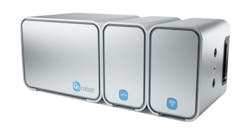Expanding Robot Use Through Easier Setup
Robots have been front and center of the automation arena for years now, driven primarily by four factors: the introduction of collaborative robots (cobots), the ability to make industrial robots act collaboratively via an array of safety devices and software, ongoing industrial labor issues and increasing ease of use—meaning that robotics experts were no longer a prerequisite for robot use.
The catch to this concept of robot ease of use has been that, though it’s demonstrably true that robot programming today is much easier than it was a decade ago, the term “easier” doesn’t necessary translate to “easy” for everyone or every application.
But ease of use is a key factor behind OnRobot’s development of its D:Ploy system, which OnRobot says is the first platform designed to automate the process of getting a robotic application up and running with zero programming and zero simulations.
In the fall of 2022, I saw a preview of D:Ploy, which is now widely available. OnRobot CEO Enrico Krog Iversen explained that D:Ploy is designed to automate the robot installation and work cell integration process through its ability to automatically discover and configure the components in a robotic cell, regardless of supplier, while also integrating external I/O from other workstation sensors and machines. Iversen said the D:Ploy system connects directly to the robot controller and handles all communication above the safety level. With this connectivity established, D:Ploy can automatically generate all the program logic, signal exchange, event handling, path planning and real-time monitoring needed for a robot application.
Essentially, there are five steps involved in using and re-using D:Ploy:
- Cell setup—D:Ploy automatically discovers the installed hardware. According to OnRobot, users no longer need to spend time setting up the robot or installing or programming the interface to control tools and other cell components.
- Workspace definition—D:Ploy’s graphical interface is used to note workspace obstacles and cell boundaries from which the system automatically generates collision-free paths for the robots.
- Application setup—Users enter workpiece attributes, pick position and other application inputs via D:Ploy’s step-by-step process. This information is combined with the cell setup and workspace definition information to generate and optimize all the program logic, signal exchanges, event handling and path planning needed for the application.
- Operate and monitor—Once the first three steps are complete, the application can be run with a click of a button. From here, D:Ploy provides real-time performance insights to drive productivity and minimize downtime.
- Re-deploy—Users can make changes and re-deploy the application as production requirements change due to the addition of a new part or to meet new packaging or palletizing requirements.
In the video below, Kristian Hulgard, general manager at OnRobot, demonstrates D:Ploy at Automate 2023.

